Scar Treatment
Scarring is a natural part of the body’s wound-healing process, but the appearance of scars can negatively impact self-esteem and confidence. Luckily, it is possible to reduce the appearance of different types of scars with various cosmetic treatment options. Atrophic scars are characterized by depressions in the skin that form due to a loss of collagen during the wound-healing process. Many acne scars are atrophic scars characterized by volume loss. Keloid scars are almost the opposite of atrophic scars and consist of raised scars that occur when excess collagen is produced in response to trauma in the skin. Unlike normal hypertrophic scars, keloidal scar tissue continues to grow beyond the limits of the initial trauma after the skin has healed. To obtain the best cosmetic results and avoid unwanted side effects, it is critical to have all types of scar treatment, including keloid scar treatments, with an experienced board-certified dermatologist, such as Dr. Michele Green in NYC. Dr. Green is an expert in treating all different types of scars, including atrophic, keloid, and hypertrophic scars.
For patients looking to get rid of a scar, many treatment options can address all types of scars. Laser treatments, such as Fraxel lasers and resurfacing lasers, can help to remove acne scars and pox scars, while laser therapy, such as VBeam laser, can also treat surgical scars, stretch marks, and keloids. Other skin resurfacing treatments, such as dermabrasion and chemical peels, are also highly effective. Dermal fillers, such as Restylane and Voluma, can be injected directly into the scar to restore lost collagen and volume loss. Botox, a standard cosmetic procedure, and topical silicone gel sheets can also prevent scar development. With so many options available, it is essential to consult with an expert, board-certified dermatologist, such as Dr. Michele Green, who can help you to create the treatment plan that works best for you and the specific type of scar you have.
Dr. Michele Green is an internationally renowned board-certified dermatologist with over two and a half decades of experience providing some of the world’s most discerning individuals with the best non-invasive cosmetic procedures, including scar treatments. She is consistently identified as one of New York’s best dermatologists by Super Doctors, Castle Connolly, and New York Magazine for her dedication to her patients and expertise. When you consult with Dr. Green at her private dermatology office in Manhattan’s Upper East Side neighborhood, she will work with you to create a customized scar treatment plan that best suits your skin type, the type of scar present, and your overall aesthetic goals.
What is a Keloid Scar?
A keloid is a firm, raised, growth-like scar. Unlike normal hypertrophic scars, keloids can continue to grow after the skin trauma has healed to extend beyond the limits of the initial wound. The color of keloid scars can vary and may change over time as the scar develops. Keloids may be flesh-colored, erythematous, or hyperpigmented. Keloids are benign growths that may cause burning, itching, or pain in the affected area. Keloids do not resolve on their own or regress over time. They can be an especially challenging type of scar to treat, and successfully reducing them requires treatment by a board-certified dermatologist or plastic surgeon, like Dr. Michele Green in New York City.
How do Keloids form?
Keloid scars form due to an abnormal amount of excess collagen production that occurs during the wound-healing process. Collagen is a structural skin protein contributing to a firm foundation and an overall youthful appearance. A keloid can form when the body produces more collagen than is needed to heal a wound. A keloid scar extends beyond the limits of the initial injury and does not regress over time, unlike normal hypertrophic scars. Keloids may form as a response to surgery, piercings, acne, tattooing, insect bites, burns, lacerations, abrasions, vaccinations, and any other process that results in skin inflammation. Some individuals are more prone to developing keloid scars. Dark-skinned individuals have higher rates of keloid development, and a family history of keloids increases the risk for their development. Keloids may develop on any body part but are most commonly found on the chest, shoulders, cheeks, and earlobes.
Creams to Treat Keloid Scars
Silicone creams can be used to reduce the size and color of keloid scars. Silicone creams are available over the counter and do not require a prescription. These products are also available as gels or as an adhesive sheet. Silicone products can be applied to old scars and those that are still healing, as long as the skin has healed over and the wound has closed. Silicone gel sheets are considered an optimal scar treatment for keloids. Silicone scar treatments should be used to cover the keloid for at least four months to attain the best results. Corticosteroid creams can negate the itching sensation that can often accompany keloid scars. Corticosteroid creams can also be purchased over the counter.
What are the first steps in keloid scar treatments?
Topical treatments
For patients looking for a milder treatment for scars, there are options for over-the-counter ointments and creams that can be used to reduce the appearance of mild scars. Over-the-counter topical products often contain such ingredients as Vitamin A and Vitamin E to revitalize the skin. The American Academy of Dermatology recommends that patients speak with a board-certified dermatologist, Dr. Green, before purchasing over-the-counter scar treatment products. Dr. Green can provide more information about the type of product that will best address your specific needs.
Another standard topical treatment for scars is the use of silicone gel sheets. These silicone gel sheets are best used on a recent wound to prevent raised scars from forming and decrease the likelihood of redness, swelling, itching, or stiffness in new scars. Researchers have found that though silicone ointment is also available, silicone gel sheets are more effective at preventing scarring. These sheets should be applied to the wound after it closes daily for as many as three months.
Steroid Injections to Reduce Hypertrophic Scars/Keloids
One potential treatment for eliminating the appearance of scars is corticosteroid injections, more commonly known as steroid injections. These steroids, however, are very different from the kind of steroids you may hear about in the media regarding bodybuilders. Corticosteroids are synthetic drugs similar to hormones that appear naturally in the body. Steroid injections are injected directly into the treatment area to decrease the size of the scar, as in a hypertrophic scar or keloid scar, with no systemic side effects. By injecting small amounts of corticosteroid injection, it helps to reduce the size and thickness of keloid scars and improve their appearance – making them smaller and flatter.
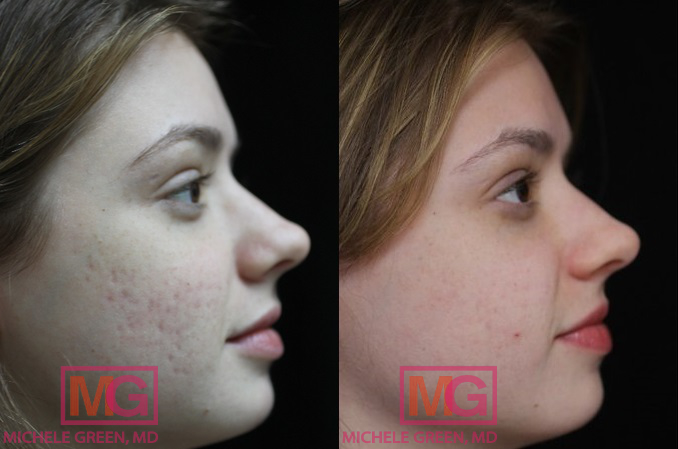
Laser treatments for Hypertrophic Scars
Laser treatments are often used in scar revision to improve the color and texture of scars. Resurfacing laser treatments stimulate new collagen production in the treatment area and reduce the appearance of depressed, atrophic scars. The V-Beam laser treatment is popular in scar revision as it is the gold standard for eliminating red pigment from the skin. V-Beam can treat post-inflammatory hyperpigmentation, stretch marks, acne scars, surgical scars, and broken capillaries. It is critical to have laser therapy with an experienced board-certified dermatologist to ensure the treatment is safe and effective for one’s skin type and tone. Using the wrong laser device or settings can result in unwanted side effects, including hyperpigmentation and laser burn. Burn scars from a laser can be even more challenging to treat than the initial concern.
Surgical Scar Revision for Keloids
Surgical scar revision may be the best option for patients with a more significant scar. Specifically, surgical scar revision can be effective for patients suffering from a significant keloid scar that is very large or has grown such that it limits movement. When choosing a surgical option for scar removal, it is essential to remember that surgery of any kind will also leave a scar, and you will be trading one spot for another. Ideally, surgical scar revision will result in a less prominent spot. However, any surgical procedure poses more significant side effects and infection risks.
What is a scar?
Scar tissue can take on many forms but appears on the skin due to the body’s natural healing process. Many kinds of scars can form due to various adverse events, and these injuries can result in the appearance of various scars. Unlike those from cystic acne or chicken pox, the appearance of burns or surgery requires different treatment modalities. If the injury to the skin goes deeper than the top layer, the scar tissue that forms is often thicker than normal skin. For patients with a lighter skin tone, scars are typically pink or red when they initially develop and may fade away with time or become darker or lighter than the patient’s regular skin color. For patients with darker skin, scars can frequently look like dark marks on the skin’s surface. A scar can form on any part of the body, and the type of scar depends mainly on the origin of the injury or lesion, how your body heals, and the formation of the wound.
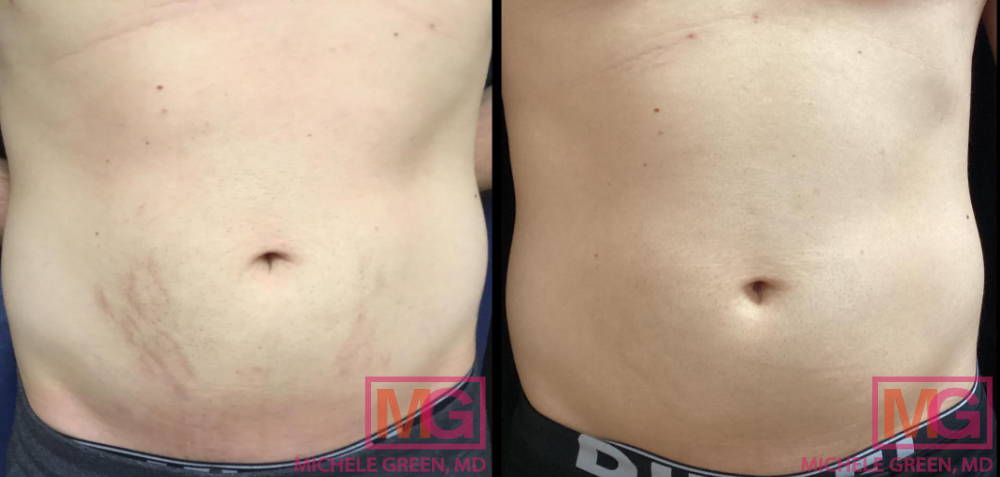
What are the different types of scars?
Various factors, including the origin of the injury, one’s genetics, and ethnicity, can influence scar formation. Different types of scars can have other appearances and textures, including the following:
Contracture Scars – Contracture scars are characterized by tightened skin that makes moving the affected area more difficult. These scars typically form after a large area of skin is damaged, such as with a burn, and can be a hindrance if the scar formation happens over a joint or if the scar tissue affects a muscle or nerve.
Atrophic (Depressed) Scars – Atrophic scars are also known as “depressed” scars because they are characterized by indentations or sunken patches of skin. These scars often form due to acne, cystic acne, or lesions relating to an illness like chickenpox. Three types of atrophic scars can occur: ice pick, boxcar, and rolling scars. Atrophic scars may become more visible with age as the natural loss of collagen further accentuates the indentations in the skin. Most acne scars are atrophic and fall into three major types: icepick, boxcar, and rolling.
View more info about Types of Acne Scars.
Hypertrophic (Raised) Scars – Hypertrophic scars are inverses of atrophic scars. Characterized by raised skin, hypertrophic scars are caused by too much collagen produced during natural healing. While hypertrophic scars can fade over time, they will never truly flatten out. Hypertrophic scars will not grow beyond the area of the injury.
Keloid Scars – Keloid scars are also raised scars that differ from hypertrophic scars in that throughout the healing process and beyond, they grow in size past the area of the injury. Red-headed patients and patients of African, Hispanic, or Asian heritage are more likely to develop keloid scars. The overgrown scars may affect a patient’s movement if the scar tissue grows over a joint.
Flat Scars – Flat scars are characterized by discoloration on the skin’s surface. These scars may be slightly raised when the wound healing occurs at first but will flatten out over time. The scar may begin as pink or red and become either hypopigmented (lighter) or hyperpigmented (darker) than the surrounding skin.
Stretch Marks – Stretch marks occur on the skin’s surface when the skin expands or shrinks rapidly over a short period, which can occur frequently due to pregnancy or rapid weight gain or loss. The stretching of the skin causes damage to the underlying tissue, resulting in a scar. At first, stretch marks often appear pink or red but will fade to a silvery color over time.
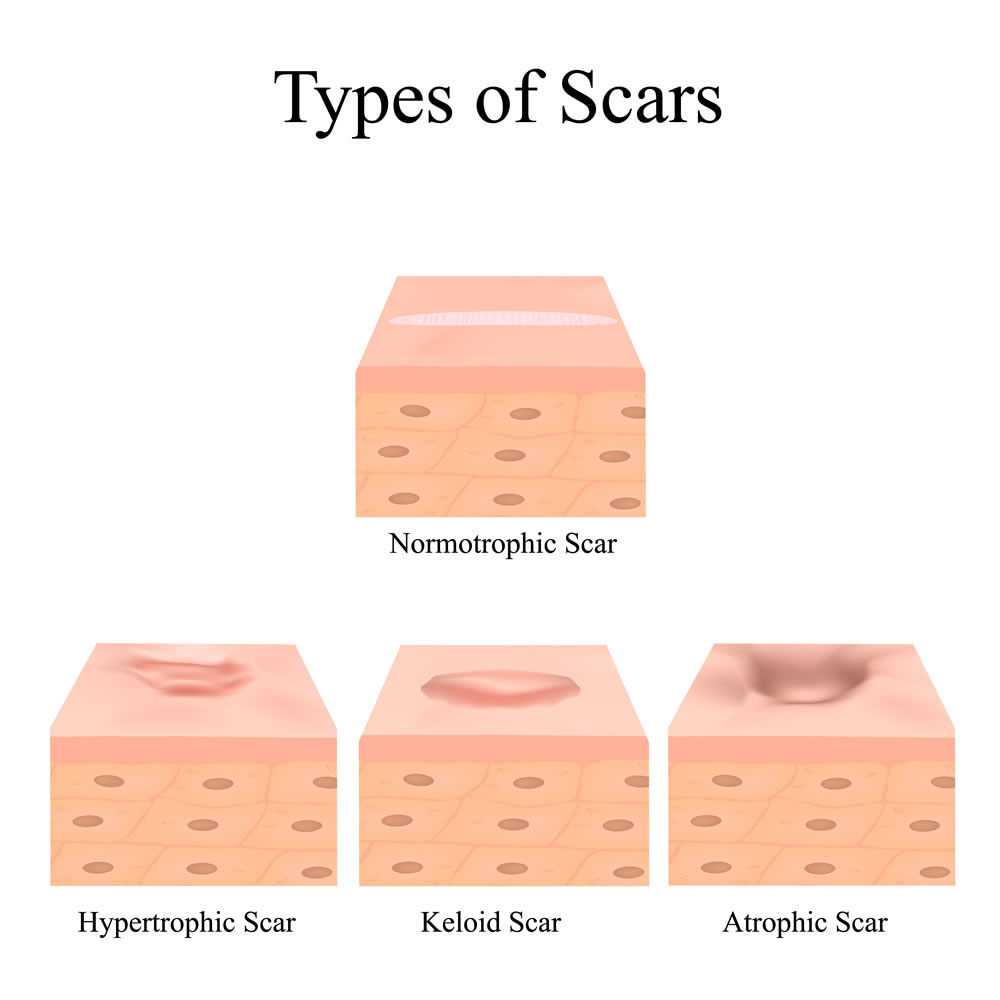
Why do scars form?
Scars form due to the body’s natural healing process following an adverse event that causes damage to the skin’s surface. Skin is the body’s first layer of defense when protecting against harmful bacteria or other substances that can lead to infection. The body’s healing process is triggered when the skin is damaged or cut, creating natural protein collagen. Collagen gives structure to the skin, causing it to appear firm and plump. During the natural healing process, however, collagen fibers form tissues that knit the skin back together to close the wound. The tissue that develops helps to protect the damage from infection, and it is this tissue that can lead to the appearance of a scar. The shape, size, and texture of a scar depend mainly on the cause of the wound and your age, genetics, and skin type.
Can scars be removed with laser treatment?
Yes! Several different varieties of laser treatments work to eliminate the appearance of scar tissue in different ways. Some laser treatments employ laser resurfacing to sand down the top layer of skin and promote skin cell turnover, while others target redness in the skin. When you have your initial consultation with Dr. Green, she will determine which, in any, laser treatment is best for your type of scar removal.
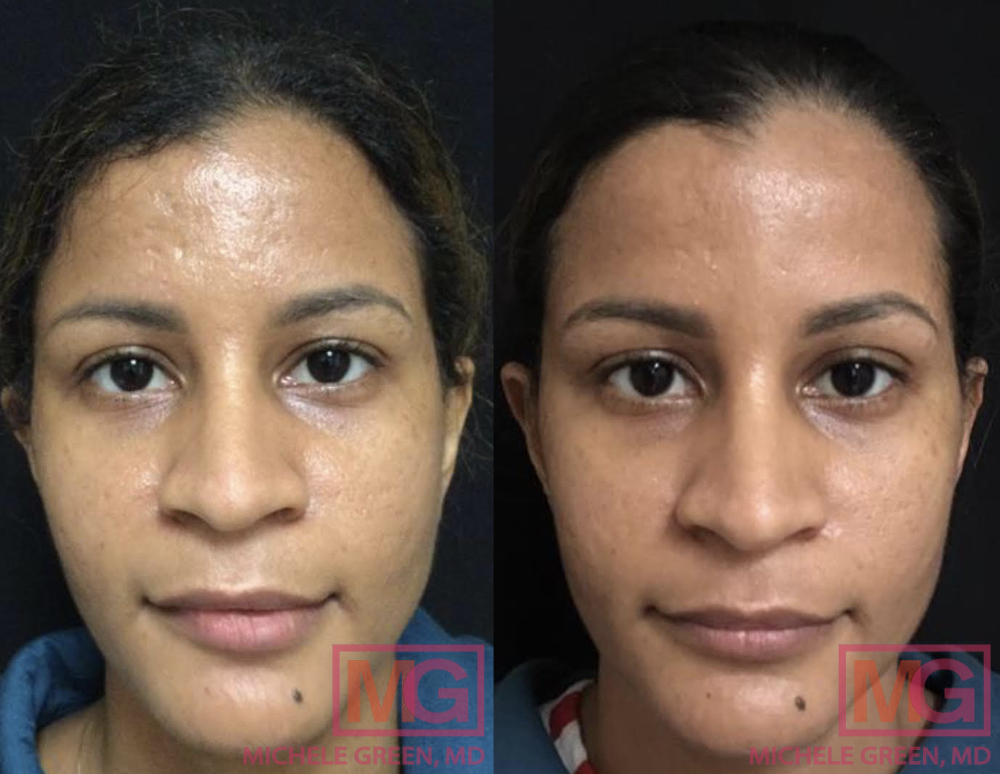
Restylane – 2 syringes for scar treatment
V-Beam Pulsed Dye Laser treatment for scar treatment
VBeam Pulsed Dye is a type of laser treatment that is best used to treat various types of scars, including acne scars, surgical scars, stretch marks, and keloid scars. The pulsed dye laser treatment involves a laser at 595 nanometers, which targets blood vessels in the treatment area. The redness in scar tissue can occur when new blood vessels form during the wound-healing process and may not recede. The appearance of those blood vessels in the scar tissue can lead to a noticeable redness in the scar. The VBeam Pulsed Dye Laser eliminates this redness in the scar by targeting the blood vessels that remain in the scar tissue. The treatment also works to flatten the raised hypertrophic scars and keloids. The VBeam laser is best for patients with a lighter skin tone with these types of scars.
The process is simple, and there is no downtime following the procedure. The procedure is painless, with most patients describing the sensation as akin to a rubber band snapping and hitting the skin. The Dynamic Cooling Device in the laser also keeps the surrounding skin cool during the bursts of laser energy, minimizing discomfort. Dr. Green will target the Vbeam laser to any area that needs treatment or is red. Following the VBeam treatment, patients can resume their regularly scheduled activities immediately. However, Dr. Green recommends careful skin care in the form of sun protection, either through sunscreen or avoidance of sun exposure.
Fraxel Laser treatment to improve the appearance of scars
Fraxel is another type of resurfacing laser treatment that effectively reduces the appearance of scars, especially acne scars. The Fraxel lasers are best used to treat atrophic scars, including atrophic acne scars, stretch marks, or surgical scars. Over a series of five to six sessions, the appearance of these depressed scars can be significantly improved through the use of resurfacing laser technology. The treatment works as the Fraxel laser device emits wavelengths of energy that create small micro-injuries spaced slightly apart from the skin’s surface. These spots induce the natural wound-healing process, which stimulates new collagen production and causes the existing collagen fibers that make up the scar tissue to be broken apart, forming new, unblemished skin. There is very little downtime and few side effects associated with the Fraxel laser treatment. The most common side effects include redness, swelling, and minor peeling in the treatment area, which resolves shortly after treatment.
eMatrix laser treatment
The eMatrix laser is a highly effective resurfacing treatment that is safe for use in all skin types. The eMatrix laser treatment is extremely effective for eliminating the appearance of acne scars and stretch marks without any risk of developing hyperpigmentation or discoloration. The eMatrix laser utilizes bi-polar radio frequency energy to penetrate the dermal layer of skin to improve the skin’s texture, eliminate scars, and reduce the appearance of fine lines and wrinkles. When the eMatrix device is applied to the skin, a pulse of radiofrequency energy is delivered, which heats the dermal tissue. This skin heating leads to a controlled micro-injury, which triggers the body’s natural wound-healing response, thus stimulating new collagen production. Over time, as collagen production increases and the skin heals, the skin’s texture improves, and the scars disappear.
The treatment process is quick and requires very minimal downtime following the procedure. Dr. Green typically recommends scheduling three to five treatments, each spaced four to six weeks apart, for optimal results. eMatrix laser treatment is advantageous as it requires much less downtime than other resurfacing treatments, only 48 hours, so you can return to your regularly scheduled activities quickly after receiving treatment.
Resurfacing lasers for scars
Laser resurfacing is one of the most effective treatment options for reducing the appearance of scars—an effective way to reduce the appearance of scars resulting from acne or pox. The laser will emit short pulses of light that work to remove the top layer of skin while heating the inner layer, which promotes the body’s natural healing process to generate skin cell turnover. The result is new, smooth, more evenly textured skin. Laser resurfacing is not the best treatment option for patients with dark skin or active acne breakouts.
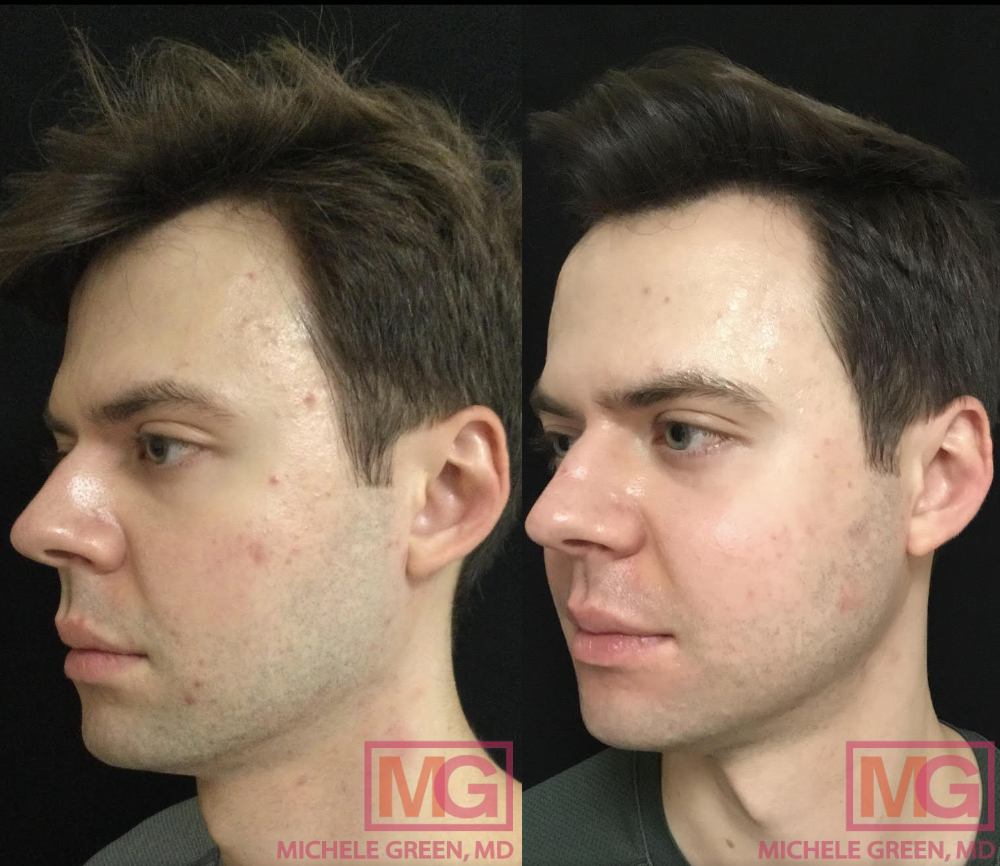
25-34 year old man, VBeam and eMatrix for acne scars
Does laser scar treatment work?
Laser treatments can be incredibly effective when it comes to scar reduction. Acne, surgical, burn, and injury scars may all be improved with various laser treatments. Although cosmetic treatments, such as laser resurfacing, can enhance the appearance of scars, it is impossible to remove a scar altogether. Utilizing just the right combination of cosmetic treatments can make your scar look completely unnoticeable, improve skin elasticity in the treated area, and reduce any symptoms that may be associated with the scar, such as pain and itchiness. Consulting with an expert in cosmetic dermatology, such as internationally renowned, board-certified dermatologist Dr. Michele Green in NYC, is the best way to understand which laser treatments best suit you and your scars. Various lasers are available for scar reduction that work via different mechanisms to improve the appearance of scars. It is best to consult a qualified dermatologist like Dr. Green to determine which laser will be most safe and effective for your scar and skin type.
How much is laser scar treatment?
The total cost of laser treatment for scar revision ultimately depends on both the size and scope of the treatment area, the number of laser treatments required to achieve your final desired results, the geographic location of the office where you have treatment, and the experience level of your provider. The type of laser utilized for your scar reduction treatment can also impact the total cost. When you consult with Dr. Michele Green at her private office in Manhattan’s Upper East Side neighborhood, she will work with you to create a customized treatment plan that incorporates the laser treatment best suited to your particular needs and aesthetic goals. At that time, the final cost of your laser treatment can be estimated.
What is the best scar treatment?
The best scar treatment depends on the scars and skin type. Some laser treatment options are unsuitable for all skin types and can run the risk of side effects such as hyperpigmentation, hypopigmentation, and scarring. The color of your scars will also influence which laser treatment suits your needs. The V-Beam laser is the gold standard for reducing redness, including scars, post-inflammatory hyperpigmentation, stretch marks, and broken capillaries. The V-Beam laser treatment operates on a wavelength that targets exclusively red pigment, leaving the surrounding skin tissue unharmed. Most patients require 4-6 laser treatment sessions to achieve their desired results.
There are many different treatment options for scars, and the answer to the best scar treatment depends on several factors, including the type of scar and the skin type of the patient. When you have your initial consultation with Dr. Green, she will examine your scar tissue and determine the treatment, or series of treatments, that will work best for you. The options you may be presented with include steroid injections, laser resurfacing treatment, Botox, topical treatments such as silicone gel sheets, chemical peels, pressure therapy, and dermal fillers. The treatments that are available at Dr. Green’s office are the safest, most effective treatments available. Some dermatologists may offer options such as cryotherapy, a process by which scar tissue is frozen off with liquid nitrogen. Treatment options such as cryotherapy are outdated because they are less effective and have a higher risk of potential side effects. A plastic surgeon may also be able to perform surgical options, such as scar excision or a skin graft.
Other Scar treatments:
Botox Treatments for scars
Botox treatment is best known for treating fine lines and wrinkles and reversing signs of natural aging. Still, recent studies have shown that it can effectively reduce the appearance of scars following cosmetic surgery. In a study illustrated by the American Academy of Dermatology, Botox was injected into half of the test subjects who received plastic surgery on their face. Immediately after the surgery, Botox was injected into the area. Researchers found that those patients had smaller and flatter surgical scars than those patients who did not receive the Botox treatment. Researchers postulate that this is due to how Botox limits movement surrounding the wound as it heals. This can help prevent the scar from becoming overly raised and reduce discoloration.
Dermabrasion for scar treatment
Dermabrasion is a treatment in which the surface of the skin is resurfaced, removing the top layer of skin to treat acne scars, pox marks, stretch marks, and surgery scars. When the top layer of the skin is removed, the result is softer, smoother skin with improved texture. Dermabrasion is best used for patients with lighter skin tones, as patients with darker skin tones are more prone to discoloration or additional hyperpigmentation due to the procedure. Further, patients with ongoing acne or skin conditions such as rashes, cold sores, or blisters should also not receive dermabrasion treatment as there is a risk of infection.
An experienced, board-certified dermatologist or plastic surgeon should only perform the procedure. During the treatment, the surgeon will begin by applying an anesthetic to reduce potential discomfort during treatment. The physician will use a specialized rotary device with an abrasive tip to “sand” the top layer of skin away. After the treatment, patients should follow their healthcare provider’s instructions about skin care. The recovery time following the procedure is relatively significant, requiring patients to take at least two weeks off of work to heal. Patients should avoid sun exposure and cleanse and dress their skin as instructed to prevent potential side effects.
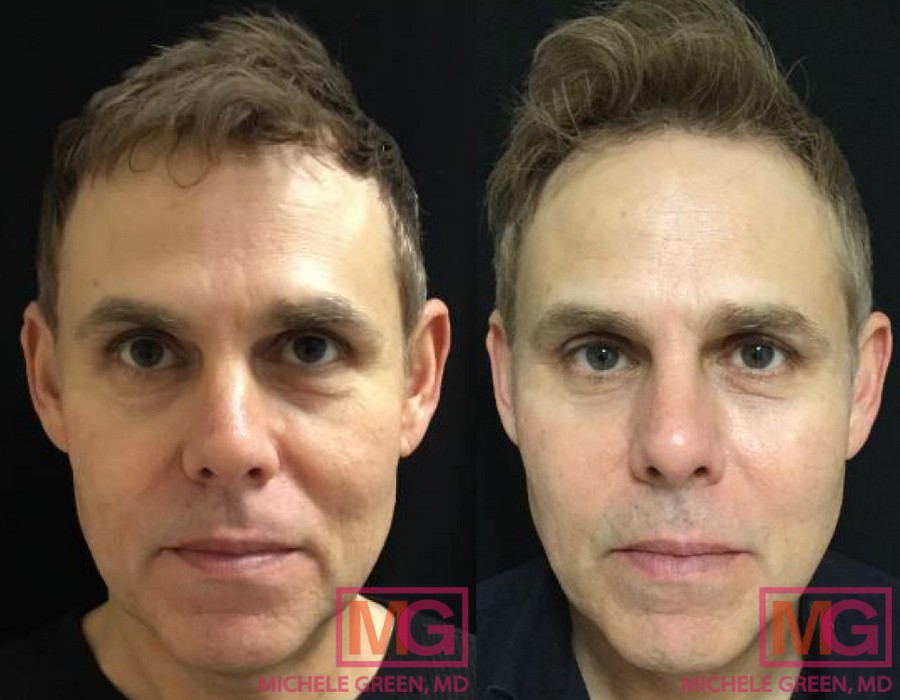
Dermal Fillers for scar treatment
Dermal fillers are a very effective treatment to restore volume to depressed scars such as atrophic acne scars. Dermal fillers can also be used as an effective scar treatment. Dr. Green commonly utilizes dermal fillers to treat fine lines and wrinkles and restore age-related volume loss to the face. Dr. Green employs a wide variety of dermal fillers at her office. Still, she most frequently uses Restylane-L, Restylane Lyft, Juvederm Ultra Plus, Juvederm Voluma, and Sculptra when treating deep scars. The procedure is simple, safe, and effective and requires no downtime following the treatment. The filler is injected directly into the depressed scar, which helps to stimulate the production of collagen. Sculptra is a unique injectable as it allows the body to produce its own collagen and improve the appearance of your skin. Atrophic scars form due to insufficient collagen, so the boost in collagen production eliminates the depression in the skin.
Chemical peels to improve the appearance of acne scars
Chemical peels are another effective treatment for resurfacing the skin and providing smooth, evenly textured skin. Chemical peels treat acne and other atrophic scars well by promoting new skin cell turnover and increased collagen production. There are a variety of different kinds of chemical peels that vary in strength and the type of acid that is used. When placed on the face, the chemicals in the peel react with the skin’s surface to exfoliate the skin’s outer layer. Patients with type I or II skin can tolerate deeper chemical peels, while patients with darker skin tones should use more gentle chemical peels. Following the treatment, it is essential to practice strict sun avoidance to prevent further damage to your skin.
How much is scar treatment?
When patients ask how much it costs to remove a scar, the answer is it depends. The cost of scar treatment depends upon various factors, including the size of the treatment area and the type of scar. For example, Patients with a vast keloid scar may require more extensive treatment to eliminate the scar, increasing the price. Additionally, some patients may require a combination of treatments to achieve optimal results, which can also affect the overall cost of the scar treatment.
Does insurance cover scar treatment?
Typically, scar treatment is considered cosmetic and not covered by private insurance companies. Insurance may cover scar treatment. You may be insured if there is documented evidence of functional impairment related to the scar, such as in a severe burn, and the treatment can be expected to improve function. The best way to determine your coverage is by contacting your individual insurance provider.
Does scar treatment work?
Yes, Scar treatments reduce the appearance of scars, helping restore self-confidence. However, some scar tissue may be permanent, and it may be impossible to remove a scar completely. Dr. Green has over two and a half decades of experience providing some of the world’s most discerning individuals with the best non-invasive treatment options, including keloids, hypertrophic scars, and acne scars. When you consult with Dr. Green at her private dermatology office in NYC’s Upper East Side neighborhood, she will work with you to create a customized scar treatment plan that best suits your types of scars, skin type, and overall aesthetic goals.
When to start scar treatment?
To achieve the best results, it is best to start scar reduction treatments as soon as possible once the scar is healed. If you are considering scar treatment for post-surgical scars, you should prioritize the full healing process of the wound first before navigating through the various scar treatments available. A consultation with a board-certified medical professional can be helpful at any stage in your scar treatment process since a dermatologist can advise regarding your healing and treatment timeline. Make sure to carefully follow post-operative instructions and wait until the wound has completely closed and healed before undergoing any scar reduction treatments or applying topicals to the scar. Before, during, and after your scar treatments, avoid sun exposure to the affected area by wearing protective clothing and SPF 50. The scarred skin area is highly susceptible to developing hyperpigmentation and skin cancer due to UV exposure.
To most effectively reduce acne scars’ appearance, whether atrophic, hypertrophic, or hyperpigmented, patients should no longer experience active breakouts of acne lesions. Controlling acne breakouts is important in scar treatment since new acne lesions can create new scars. Patients who first undergo acne treatment to prevent future flare-ups enjoy long-lasting results when treated for their scars. If you are struggling with acne, Dr. Green can help. Depending on your medical and family history, skincare routine, lifestyle, and hormone levels, Dr. Green may recommend acne treatments such as Accutane, spironolactone, or oral/topical antibiotics to prevent breakouts. Once the acne has been effectively managed, acne scar treatments can be started so that patients can enjoy smooth, clear, healthy skin that lasts.
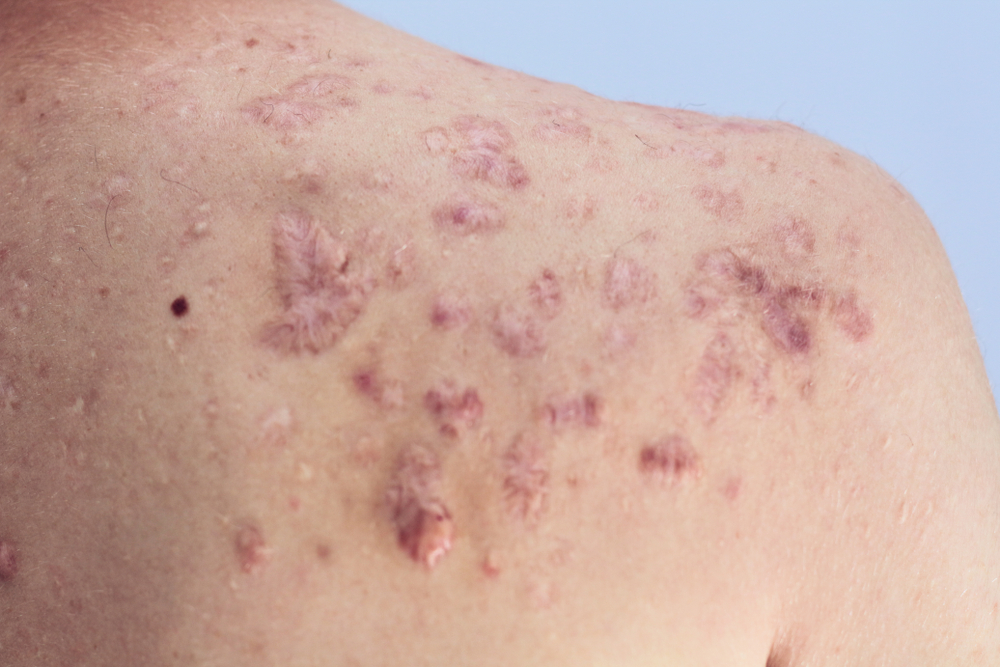
When to start scar treatment after surgery?
Generally, it is best to wait at least three months after a surgical procedure before considering scar reduction treatments. Ensuring the wound is completely closed and healed before undergoing scar treatments is essential. Post-surgical instructions must be followed carefully to prevent scar formation. After the wound is fully healed, the scar can be assessed by Dr. Green to discuss the best treatment options. Because there are so many options available for treating scars, it is best to consult an experienced, board-certified dermatologist like Dr. Green, who can determine what type of scar you have, when to start treatments, and which treatments would be safest and most effective.
What is the best scar treatment for old scars?
Dr. Green may recommend combining treatment options such as dermal fillers and resurfacing laser treatments for old scars. The eMatrix sublative rejuvenation laser treatment and Fraxel laser are ideal for targeting old scars. The eMatrix laser relies on radiofrequency energy to create micro-injuries in the dermal layers of the skin, stimulating new collagen production in the treatment area. The eMatrix can be an excellent treatment for treating old, white-colored stretch marks. Dr. Green often refers to the Fraxel Dual laser treatment as the “magic eraser” for its unique ability to address a wide range of skin concerns, including the appearance of scars. Fraxel operates on two distinct wavelengths, the 1927 and 1550 nm. The 1550 nm stimulates new collagen production in the dermal layers of skin while leaving the outermost surface layers intact and is ideal for treating stretch marks, surgical scars, fine lines, and acne scars.
Collagen is a structural protein in the skin that provides a firm foundation and contributes to an overall youthful appearance. Minimal downtime is involved, with most patients experiencing side effects of temporary redness, dryness, and peeling in the treated area. It is essential to refrain from sun exposure in the treated area following each treatment session, as the laser treatment increases the skin’s photosensitivity, which makes one more susceptible to UV damage. Most patients require 4-6 laser treatments to achieve their desired results.
A dermal filler is a type of cosmetic injectable designed to give the skin a smoother texture by ‘filling’ in the gaps left by the collagen loss, which causes atrophic scarring. Dermal fillers are also a popular cosmetic treatment option for improving the appearance of fine lines, age-related volume loss, or enhancing certain facial features. Some of the most popular dermal fillers for improving the appearance of scars include Restylane, Juvederm, and Sculptra.
Sculptra is a unique dermal filler composed of a substance called poly-L-lactic acid that stimulates new collagen production in the treatment area. Sculptra is an excellent treatment option for targeting atrophic scars, including acne scars and depressed stretch marks. Over time, as collagen is produced, the skin texture becomes smoother, reducing the appearance of depressed scars. Most patients require an initial series of three treatment sessions to achieve ideal results and the effects of this innovative filler treatment last for up to two years.
Dermal fillers such as Juvederm, Voluma, Belotero, and Restylane are composed of hyaluronic acid, a naturally occurring substance in the skin that contributes to hydration and an overall youthful appearance. Depending on the type of HA filler used and the patient’s metabolism, the filler lasts 6-18 months. Dr. Green often performs subcision in conjunction with dermal filler injections, a technique that stimulates new collagen production in the treatment area and provides a long-lasting smoother skin texture. This treatment option is highly effective for atrophic scars due to the immediate volume restoration provided by the HA injectable filler and the long-term effect of producing new collagen provided by subcision.
What are the best oils for scar treatment?
Many oils have anti-inflammatory and healing properties that can potentially benefit wound healing and scar treatment, though there is little clinical evidence. Topical Vitamin E and tea tree oil are two types of essential oils that have anecdotally helped prevent and treat scarring.
What is the best scar treatment for a tummy tuck?
Traditional tummy tuck scars extend from hip to hip and can take up to one year to heal completely. Many patients struggle with redness and irregular skin texture following a tummy tuck. Laser treatments such as V-Beam and Fraxel can work wonderfully to reduce the appearance of a tummy tuck scar. The V-Beam laser operates on a wavelength that targets the red pigment in the skin, leaving the surrounding tissue unharmed. The pigment absorbs the energy from the laser and is destroyed. Fraxel resurfacing laser treatment can improve the texture of a tummy tuck scar, smoothing the skin’s surface so that the scar is much less noticeable. Many patients choose to combine these laser treatments in their scar revision plans to optimize their results.
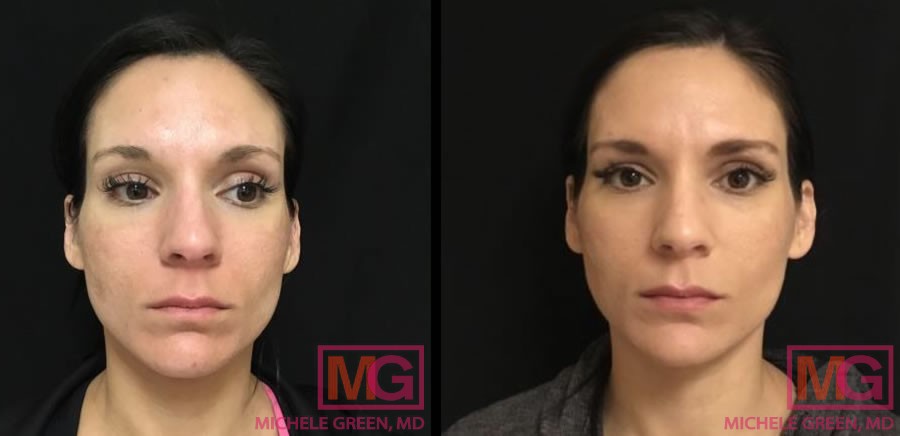
eMatrix for acne scars
How long should you wear silicone scar sheets?
Patients who are undergoing topical treatment for the prevention of scars may be prescribed silicone gel sheets. The silicone gel sheets effectively reduce the scar’s size and minimize potential discomfort, such as itchiness, during the healing process. However, patients must wear the sheets as recommended for the treatment to be effective. Most patients will be asked to apply the sheets to the wound for 12 to 22 hours daily for up to three months.
How much is scar treatment abroad?
It is important that your scar treatment is performed in a medical setting by a certified healthcare professional to ensure that the treatment is safe and effective, produces ideal results, and avoids unwanted or dangerous side effects. Prices abroad can vary significantly depending on the country, the establishment in which you’re treated, and the experience level of your provider. Consider the potential risks of traveling abroad to have scar treatment before planning a trip.
How do I get started with scar treatments today?
Scars are a natural part of the skin’s healing process, but they can negatively impact one’s confidence, mainly if located on a visible area like the face. Scars can also be a constant reminder of a negative or traumatic experience that can lead to depression and anxiety. Scars are permanent but gradually improve and fade over time, usually up to two years, depending on the scar’s severity and location. You may already have tried creams, gels, and lotions sold over the counter that claim to make the scar disappear, to no avail. Don’t worry; you can take steps to facilitate the healing process or undergo the various scar treatments available to diminish the appearance of an existing scar. Because there are multiple types of scars and scar reduction treatments, it is best to consult a qualified dermatologist like Dr. Green, who can determine your scar type and the best and safest treatment option. Until you can begin your scar reduction treatments, ensure you protect the area from sun exposure by applying sunscreens and wearing sun-protective clothing.
In non-invasive cosmetic treatments, including Botox, dermal fillers, anti-aging laser treatments, and scar reduction. If you feel defeated by the persistent scar that you are bothered by, don’t worry, Dr. Green is here to help. In her private Upper East Side dermatology office, Dr. Green will carefully assess your skin and discuss your aesthetic goals to achieve a healthy, even, natural-looking complexion. Dr. Green utilizes the latest technology and techniques to ensure quality results.
Dr. Michele Green is an internationally renowned board-certified dermatologist with over two and a half decades of experience providing some of the world’s most discerning men and women with the best non-invasive cosmetic procedures available, including scar treatments. She is consistently identified as one of New York’s best dermatologists by Castle Connolly, New York Magazine, and Super Doctors for her dedication to her patients and expertise. When you consult with Dr. Green at her private dermatology office in Manhattan’s Upper East Side neighborhood for your scar revision, she will work with you to develop a customized scar treatment plan that best suits your needs and goals. To schedule a consultation with Dr. Green, please contact us online today or call the office at 212-535-3088 to see which treatment options will work best for you.
 212-535-3088
212-535-3088